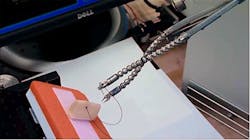3-D vision system automatically tracks anatomical structures
Three engineering professors at Columbia University (New York, NY) have developed a vision-based system that can be used to help surgeons perform minimally invasive surgery.
Columbia professors Peter Allen, Nabil Simaan and Dennis Fowler created the so-called Insertable Robotic Effector Platform (IREP) which sports a pair of snake like arms equipped with surgical instruments and a 3-D stereo vision imaging system. It has been designed to help surgeons perform operations such as single-port gallbladder surgery.
The 3-D vision system, which includes two controllable miniature CCD cameras, can be used to automatically track anatomical structures and surgical tools during a procedure, providing real-time in-vivo viewing for the surgeon. Using stereo reconstruction methods, surgeons can also model the patient’s internal anatomy and register it with pre-operative CT, ultrasound, or MRI scans.
The IREP's flexible snake-like arms, which each have seven degrees of freedom, are moved by a push-pull actuation mechanism. Tubular channels within each surgical arm can also be used to deliver drugs and provide suction.
Recently, the researchers licensed the system to Titan Medical (Toronto, Ontario, Canada). Under the terms of the agreement, the company will have exclusive rights to its development and commercialization.
According to the company, the IREP will enable surgeons to carry out minimally invasive procedures by using natural openings and by using only a single small 15 mm opening in the abdomen, as opposed to the three to five openings currently used in existing minimally invasive systems.
A complete technical description detailing the design of the system is available here.
-- by Dave Wilson, Senior Editor, Vision Systems Design
